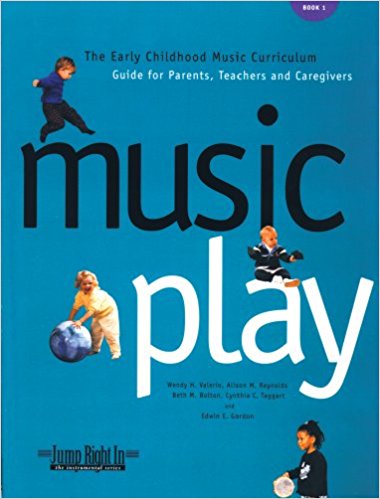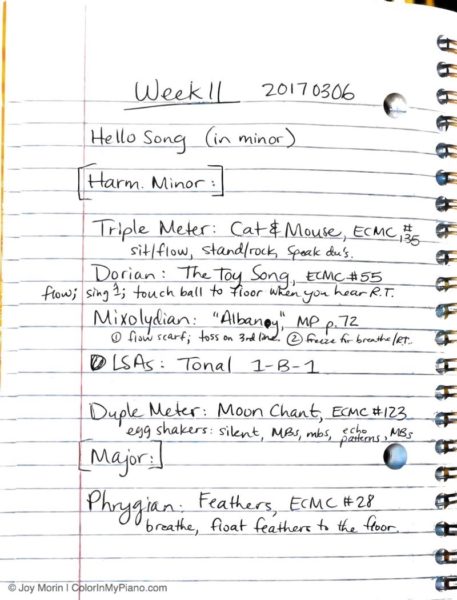Since taking the Piano Certification Course through the Gordon Institute for Music Learning (GIML) last August, I have been slowly but surely working towards integrating Music Learning Theory (MLT) principles into my teaching approach.
Much of this integration is subtle at this point and yet, it is having a definite impact on my students.
I’ve also had the opportunity to experiment more directly with an MLT-based teaching approach in a couple of new group music classes I’ve been offering over the past few months.
The first opportunity arose when one of my piano parents asked if I might consider doing some kind of group music class with her two piano students as well as three of her other children who take lessons in guitar, flute, and violin. She was interested in her kids receiving additional help with rhythm, theory, and more, to support their private lessons. I told her more about the GIML training I received and how I felt it would be ideal for her kids and that I would be thrilled to have the opportunity to experiment more with this approach. So, now I’m teaching a weekly 30-minute group music class (not geared towards piano playing) with 5 siblings between the ages of 7 and 12. Afterwards, I give the two piano students their private lessons.
 The second opportunity arose when a local violin teacher reached out to me asking about lessons for her 4-year-old son. Ultimately, we settled on having a weekly 30-minute group class with her son as well as her two other young children. The five of us are exploring music together using the Music Play early childhood music curriculum as the basis.
The second opportunity arose when a local violin teacher reached out to me asking about lessons for her 4-year-old son. Ultimately, we settled on having a weekly 30-minute group class with her son as well as her two other young children. The five of us are exploring music together using the Music Play early childhood music curriculum as the basis.
So far with both classes, I’ve been loosely following the lesson plan outline that Marilyn Lowe suggests in her Keyboard Games (KG) books (see image below). I’m pulling songs and rhythm chants from her KG books, Music Play, and the ECMC Songs and Chants Without Words, Book One.

In 30 minutes, I don’t always have time to do songs in all of the tonalities listed on the suggested lesson plan, so I generally skip one or two of them in a given lesson and then make sure we sing something in those modes the following week.
With both classes, we are keeping the focus of the activities around exploring movement (flow, weight, space, and time — à la Laban), coordinating the breath, using our head voices when singing, hearing a rich variety of meters/tonalities, finding the resting tone, and finding macrobeats (big beats) and microbeats (little beats).
With the older class, we are beginning to get into higher levels of audiation — musical thinking that is undergirded by comprehension. Gordon divides music study into two main aspects: tonal and rhythm. Within both aspects, we explore both context and content as part of developing audiation. Rhythm CONTEXT refers to understanding tempo, the macrobeats versus microbeats, and meter (as either duple, triple, or a combination). Rhythm CONTENT refers to specific measures of rhythm, aka “patterns”. Most approaches to music study focus on content without giving much attention to context. Content, of course, doesn’t make as much sense without having context. 🙂 Through comparing the macrobeats to the microbeats, my students have already learned to audiate and therefore identify unfamiliar music as either duple or triple. So exciting!
On the “tonal” side of things, I’m pleased to hear my students singing accurately in tune using their head voice. They are consistently able to find and sing the resting tone (tonic). They are being exposed not only to major and minor, but also all kinds of other tonalities: dorian, mixolydian, lydian, etc.. Most approaches are largely limited to major and some minor. Going forward, I plan to continue on the “tonal” front work towards further audiation of tonal function (both melodic and harmonic) and eventually being able to identify a given tonality.
With the older class, I also insert “LSA” (Learning Sequence Activity) time in the middle of the lesson plan. This is where we follow a specific sequence of instruction that helps us build audiation skills.
We spend a lot of time in class not just echoing but also creating our own rhythm or tonal patterns. We are truly learning how to “think in music” and “speak in music”. I’m so excited by what I’m seeing happen in this music class. This is truly music literacy!
Stay tuned for future blog posts where I will continue journaling and documenting my journey with integrating MLT into my teaching philosophy and approach.
Update: Read What Is Audiation, Exactly?



I had the pleasure of teaching a national early childhood program for infants, toddlers and preschoolers and their parents or caregivers (I don’t want to mention the name in case of copyright infringement). Although it’s been over ten years since I last taught those classes, so many key words popped up in your post that brought back memories. Teachers were encouraged to use “parent education” moments during classes to explain macro- and microbeats, resting tone and exploring various tonalities. We also frequently used songs and chants without words, explaining that vocables took the stress out of remembering lyrics and focused on the music itself. When I gave up my program license to teach piano privately it never occurred to me to apply what I taught in those classes to my piano students. I’m going to have to brush up on those terms and introduce them to my students. Thanks for an interesting, informative post!
Great post! Thanks for sharing.
Beautiful post. Thanks for sharing.